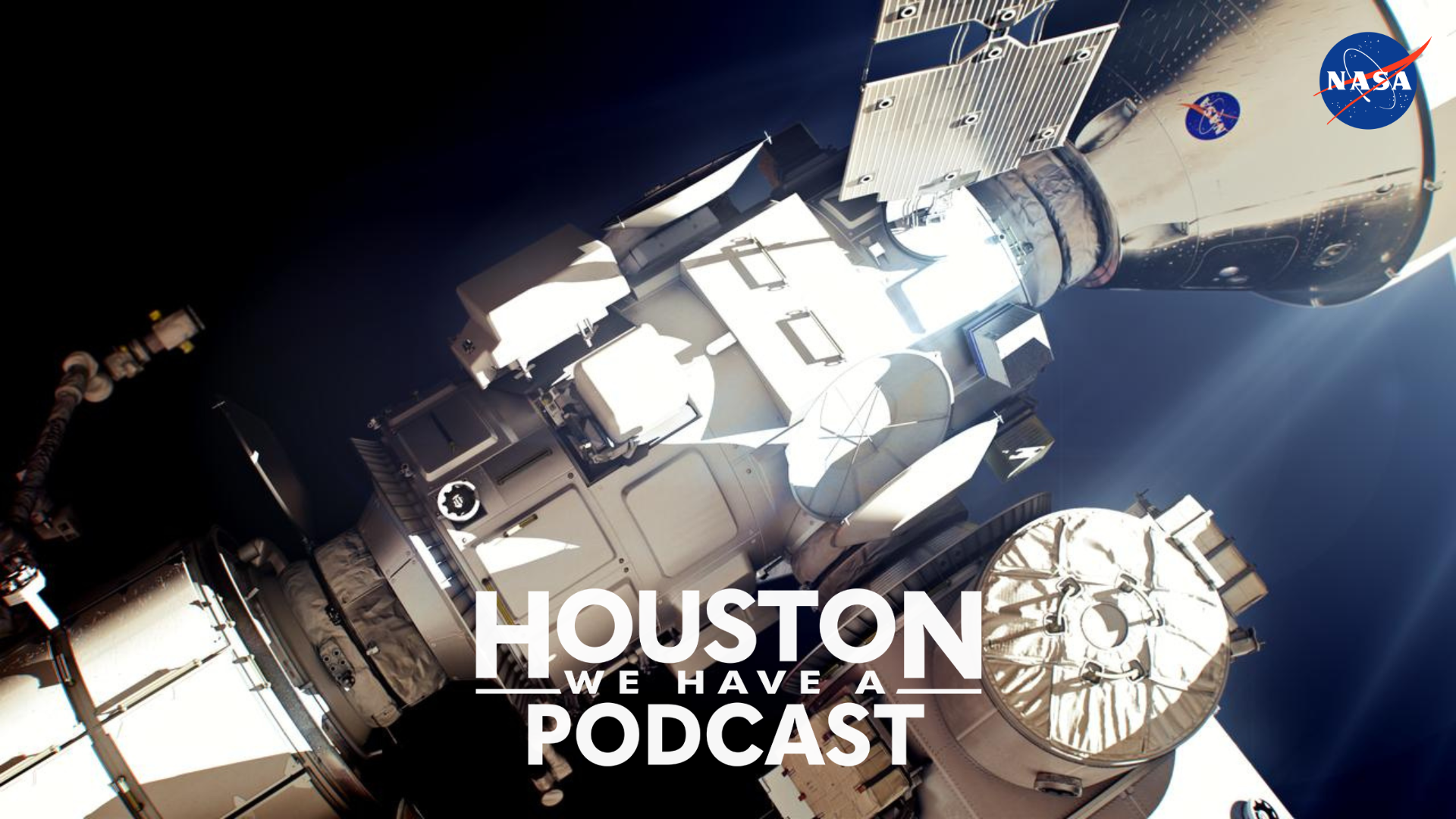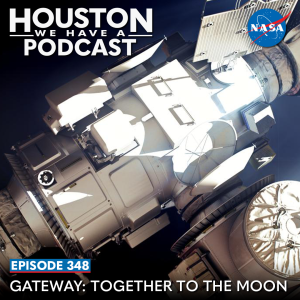
From Earth orbit to the Moon and Mars, explore the world of human spaceflight with NASA each week on the official podcast of the Johnson Space Center in Houston, Texas. Listen to in-depth conversations with the astronauts, scientists and engineers who make it possible.
On episode 348, European Space Agency astronaut Luca Parmitano discusses the international elements of the Gateway lunar space station. This episode was recorded on July 17, 2024.

Transcript
Host (Courtney Beasley): Houston, we have a podcast! Welcome to the official podcast of the NASA Johnson Space Center, Episode 348, “Gateway: Together to the Moon.” I’m Courtney Beasley and I will be your host today. On this podcast, we bring in the experts, scientists, engineers, and astronauts all to let you know what’s going on in the world of human spaceflight.
In episode 344, you heard NASA astronaut Randy Bresnik and engineer Stephanie Dudley introduce Gateway and share how it will support a new generation of scientific discovery on the lunar surface and in deep space. If you haven’t listened to that yet, it’s really great introduction to Gateway and I recommend you give it a listen. For our second installment in our monthly Gateway series, we are going to dig into some of the international elements of the station from ESA, the European Space Agency, and JAXA, the Japan Aerospace Exploration Agency. And who better to tell us all about those than the international astronaut working on Artemis, ESA astronaut Luca Parmitano?
Luca was selected as an ESA astronaut in 2009. He’s from Italy and considers Catania to be his hometown. His first mission to the International Space Station was in 2013, where he participated in hundreds of science experiments and two spacewalks. He went back to the station in 2019 where he conducted even more science, became the first Italian to serve as the Commander of the International Space Station, and completed four more spacewalks for a total of 33 hours and nine minutes spent in the vacuum of space. In recent years, Luca is ESA’s Lead Astronaut and the European Astronaut Center’s JSC liaison officer, spending much of his time traveling between Europe and Houston. He wears many hats, like training astronauts for spacewalks and most relevant for today’s podcast, bringing his astronaut experience to bear for Artemis, NASA’s return to the Moon, which includes Gateway, the lunar space station, where astronauts like Luca will live, conduct science, and prepare for missions to the lunar South Pole region. For today, true to his nature, Luca will talk about how both ESA and JAXA are central to Gateway. Let’s go.
[Music]
Host: Alright, well, Luca, thanks for coming on Houston We Have a Podcast today.
Luca Parmitano: Thank you for having me.
Host: This is your first time on the podcast and we’re going to talk all about Gateway today, specifically the first two missions to Gateway, Artemis IV and Artemis V. And the reason we have you here to talk about it is because both ESA and JAXA play important roles in both of these missions. So we’re covering both ESA and JAXA because ESA is providing various components that JAXA is contributing hardware to. So before we get started, since this is your first time on the show, I’d love to help our listeners understand a little bit more about who you are. So, can you tell us a little bit about where you were born and where you grew up?
Luca Parmitano: Sure. I hope it’s not too boring, so I was born in Sicily a long time ago and I grew up in Sicily. I went to school there until I was 17 years old, and then I won a scholarship to be an exchange student in the U.S. That was my first experience in the U.S. After that, I went back, finished high school, and I joined the Air Force, went to the Air Force Academy for 40 years, and then after graduating from the Air Force Academy, the Italian Air Force Academy, I came back to the U.S., this time in Texas, to become a pilot, a military pilot. I got my wings in 2001 and joined my squadron. Flew as a fighter pilot for about seven years, and then the Italian Air Force selected me to become a test pilot. And then that’s basically where my career as an astronaut started, because after I finished test pilot school, the European Space Agency had a call for astronauts in 2008. That’s when I joined the European Space Agency. And then I flew in 2013 and 2019 for a total of exactly one year on orbit, on the ISS on two different missions.
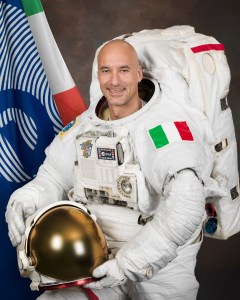
Host: Not boring at all, I promise. So it sounds like you loved to fly, obviously being a pilot, but when did you start thinking about the reality of going to space?
Luca Parmitano: The reality of it? It didn’t feel real until I got a phone call one night while I was in France telling me, “Hey, do you want to come to Paris? We selected you as an astronaut.” So that’s the first time that it became real. But as a dream or more than a dream, as a path, at being part of me for as long as I can remember.
Host: And what made you want to travel into space? Were there any things that happened when you were a child that sparked your interest?
Luca Parmitano: Well, the question is the other way around. Who wouldn’t want to travel to space, especially if you grew up in the ‘80s? I grew up around Japanese cartoons. They were all about space and space adventures and, you know, Star Wars and Star Trek. So as a kid, like all kids, I mixed reality and fantasy. So to me, Star Trek, Star Wars, and seeing the first shuttle missions fly to orbit were one and the same. And for many years I thought that that humankind was permanently on the Moon. And when I realized that we were not, that was quite a shock. It was probably nine or 10 years old. So, you know, we desire what we see. And seeing that on TV, seeing those first flights of the space shuttle, seeing the astronauts in their white spacesuit working, I thought back then that that was a dream job and it stayed a dream for a very long time, but somehow it turned into reality at one point.
Host: Yeah, exactly. And now here you are with a couple of spaceflights under your belt. You’ve spent just over a year in space, over two long duration missions, and you participated in a lot of science while you were up there. You were Commander of the space station, and you did six spacewalks. What has all of this experience taught you?
Luca Parmitano: Well, I would say that there’s too much to just say in a few sentences, but I would say that first and foremost, I think about the people that make it possible. It’s too easy to just focus on the few that have the chance to fly in space and perform up there. But really, when I think about my experiences and what I learned, it comes down to who prepared me and how and all the process that turns just a very regular guy like me into an astronaut and capable of performing those tasks up in on the space station. Secondly, it taught me about a lot about myself, about the things that I can rely on and the things where I really need to rely on somebody else. It taught me a lot of patience, also, something that doesn’t come naturally to me.
Host: Well, now we will turn to Gateway, which is the reason that you are here today. It’s being built as we speak, and it’s going to play a really important role in the long-term Artemis missions, starting with Artemis IV, and I know ESA is playing a big role in Gateway. So I just wanted you to tell us a little bit about that.
Luca Parmitano: Well, it turns out you just said it’s being built as we speak. I actually happened to have seen it only about a month ago. I was in Italy at Thales Alenia Space and I was there for a human-in-the-loop phase of testing of what we call the International Habitat, or I-Hab, which is the European contribution to the Gateway. And while I was there, they gave us a tour and it just so happened that HALO, which is the U.S. component of the Gateway, was being tested on a rig. And it was really cool to see that and to think that in a few years that piece of equipment will become alive with noise and equipment and all the rigging that you need in order to turn a piece of metal into a space station.
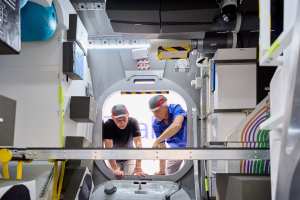
So the way I see it is, right now, going back to the Moon has to be an international cooperation. I don’t think anybody has any doubts that the resources and the efforts required to make this happen are just too much for any single nation to go on their own. So, this fantastic international corporation, right now we have four space agencies, NASA and ESA, foremost. We have, the Japan Aerospace Exploration Agency, JAXA, and CSA all cooperating towards this endeavor. The contribution from the ESA side is I-Hab. So a module, which is really the tween of HALO, for which will be the main modules of the Gateway, and then some other components that will be installed in and outside of the space station.
And like you said, JAXA is also cooperating with some of the components that will go inside. Where we are right now is really in the development phase where we know what the structure looks like. We know what the structures will do and the components that will go on it. But now we have to look at the inside and say, “How are we going to live inside Gateway?” You know, where are we going to sleep? Where are we going to eat? How are we going to work? How do we move inside this piece of equipment? So, it’s really exciting. My background as a test pilot helps me a lot in that because there’s a lot of overlap in what I did as a test pilot and what I’m doing now with Gateway.
Host: So Artemis IV is really ambitious because it’s the first time that we’re going to assemble the space station elements around the Moon for astronauts to live and work. But what about Artemis V?
Luca Parmitano: So Artemis V will have another element coming to it, which is called the ERM, or at least that was the initial programmatic name, the ESPRIT Refueling Module. But recently there’s been an update of the names for, for all the different components and the ERM, the ESPRIT Refueling Module, it will be called the Lunar View because it has windows. And I actually got a view of those windows while I was in Italy testing the Gateway, testing I-Hab. So it will be an absolutely important addition. Why are windows so important? Even though most of the time the Gateway will be quite far away from the surface of the Moon, it never gets as close to the Moon as the International Space Station is to Earth. But can you imagine going to the Moon and not being able to have a view? I don’t think it’s imaginable. So having those windows will be of the utmost importance, whether you’re looking at the Moon or, like I suspect, spending a lot of time looking at the Earth.
It will be interesting because at this point, we will have already assembled most of the Gateway. It will be already an inhabitable environment. And then with ERM, we are enlarging the scope and looking at our capability to service the space station, the Gateway, looking at adding capabilities in terms of logistics, in terms of also refurbishing it, in terms of providing resources to it. So, ERM will be another very important addition because as opposed to the International Space Station, Gateway is quite small. When we look at the size, it’s about one third, one quarter of the size International Space Station. It will not be permanently inhabited, but we will still have people living there for relatively extended amount of time. So being able to enlarge it and to make it more comfortable, to add more volume, is part of what we’re trying to do with the Artemis V mission and the addition of ERM.
Host: So ESA is providing entire segments of Gateway, but I understand that ESA’s contributions don’t stop there. Can you tell us about the Lunar Link module?
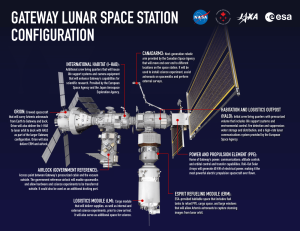
Luca Parmitano: So the Lunar Link is the main element that will provide constant communication between the ground and the Gateway. And when I say constant, I really mean it because for the first time with the lunar Gateway, we will be going in an orbit that is completely different from what we usually expect. If you can visualize the orbit plane of the Moon-Earth system, it’s almost like a disc with the Moon rotating around the Earth. And until now, including Artemis I, every single mission that we have sent to the Moon lies on that plane. Now, we will be changing that with the Gateway rotating on a plane that is perpendicular to that plane. It is called “halo orbit,” and specifically, the one that we will be choosing, it’s called, “near-rectilinear halo orbit,” and that’s due to the fact that when you project that on a 3D map, it really looks just like a line. The advantage of that is that the Gateway will be going by the poles of the Moon, which is something we’ve never done before. But also, the other advantage is that you will see the Earth continuously, and so we will have continuous communication with the Earth. The thing that’s exciting about the Lunar Link is that it will be serviceable on principle, but it’s being designed so that it will never have to be serviced while it’s up there. So, I was involved with it in reviewing the design so that in case something happens, we can go outside and repair it, you know, change antennas maybe, or reconfigure the cabling. But the way it’s being designed, it will be independent and not need any service.
Host: This is also cool. Can you tell us a little bit about how JAXA fits into all of this?
Luca Parmitano: So, absolutely. It’s exciting and, first of all, and let me tell you, I’m excited working JAXA and my Japanese colleagues because it’s always an incredible pleasure working with them. They are super motivated and their whole culture, it’s fascinating and it’s a pleasure interacting with them. So the Japanese Space Agency is providing some of the most important components inside the Gateway. They are the ECLSS system, and that’s the environment life support system. So, it’s all the components that generate an atmosphere, that clean it, that create ventilation and so on. Really, really important because if we want to put humans anywhere inside a space station, we need those system to survive. So, it will be an integrated work where the European Space Agency is providing the module, some of the science, some of the systems, including the energy systems, some of the system that control the atmosphere, the computers and so on. But the environmental life support system is going to be provided by JAXA, and that’s where they fit in. And part of the testing that we did recently was to see how we move around those systems, how do we interact with them, how we interface with them, and so on. So, it’s been a very close cooperation.
Host: You briefly mentioned science and Artemis is obviously all about science, and Gateway is central to Artemis. I understand that ESA and JAXA are working together on some really important science experiments. Can you tell us a little more about what those are?

Luca Parmitano: I can, meaning that what we are working on is how are we going to perform science on the Gateway? So at the stage that we are right now, it’s really about configuring the Gateway in a way that humans will be able to perform science. What I know right now is that there is a dedicated space for—imagine a pallet where we will be able to install experiments. These will be experiments that can go back to Earth and be exchanged, so that we don’t have a fixed experiment that eventually runs out, but it we will be able to refurbish it to change it. And so we are dedicating a specific part of the volume, even though the volume is already so small, the science side of it is so important, and we are dedicating part of the volume to science. So it will be an environment where we can install experiments, run them, uninstall them, bring them back to Earth and see how an environment like the lunar orbit affects our science. Because here’s the thing, people on the ground, they asked me, “Hey, Luca, you went on two missions, you performed a lot of science. What are the results?” And I have to explain to them that science is science no matter where you perform it. And when you do science on Earth, it takes years before you can publish a result because it has to be confirmed. It has to be reviewed, it has to be, in a way, it has to be confirmed because sometimes it can be hard to gather all the data and come out with a story. And what we have found out in the past 20 years on the space station is that some things on orbit behave just the same way, and then some things don’t. So it’s the same science, but the results are different.
So can we expect that to happen on Gateway? I’m not a scientist, but I would say yes, we can, because there are differences between low Earth orbit and the Moon orbit in that, for example, being 400 kilometers above the surface of the Earth still puts us inside the magnetosphere. So everything inside the space station is protected by the magnetosphere from cosmic rays, for example. When you go away from that, when you go 1000 times further away, almost is exactly 400,000 kilometers away, now you’re exposed to a completely different environment, especially the cosmic environment. So we do expect different results, and that’s why having a platform that is, I would say adjustable, where we can bring experiments, bring them back, modify them, find the answers, and more importantly, find new questions. It’s part of what we’re doing right now.
Host: And what exactly is your role in the Gateway with ESA?
Luca Parmitano: Wow, that’s a great question. Thank you for asking that. Quite proud. I am the crew rep, which means I represent my crewmates for the European Space Agency. So right now, we have a class of astronaut from 2009 that is still active. I belong to that class. We have a new class of astronauts. And my role is to represent all of them when I attend the meetings, when I do the testing, when I provide my perspective on the design, on the improvement. And that’s one side of my role. And then the other side is that being experienced in Extravehicular Activities, like you said, I perform six of them. I’m also leading the efforts to create an environment outside Gateway that is compatible with Extravehicular Activities.

Host: Well, I think the most important question of the day that I want to end on is, do you want to visit Gateway?
Luca Parmitano: Well, I would not be an astronaut if I didn’t put every effort into trying to achieve that dream. I’ve been looking at the Moon for my whole life, looking up and dreaming of the Apollo missions, reading about them, watching movies. And I know that my generation of astronauts, at least for sure probably my class, will not have a chance to set foot on the Moon. And that’s okay. But I really hope to have the chance to contribute to the program in any way I can. And if that means building the, you know, the steppingstones for mankind to go, building the steppingstones for humanity to go back to the surface of the Moon via Gateway, then I’ll be really, really happy to contribute like that way. It’s exciting.
Host: Well, maybe we’ll see you up there one day.
Luca Parmitano: I surely hope so.
Host: Well, thanks again for your time. This was so much fun, and you helped us learn a little more about Gateway. Thanks for joining.
Luca Parmitano: Thank you for letting me.
[Music]
Host: Thanks for sticking around. We have at least two more episodes coming your way about Gateway. Those will cover Gateway’s robotics, cargo spacecraft, and the Airlock. And we’ll take a glimpse into the future with what happens with Gateway after it’s finished being built. Our full collection of episodes, including the first part of this Gateway series and so much more, is on nasa.gov/podcasts. You can also find many other wonderful podcasts we have across the agency there. You can learn more about Gateway at nasa.gov/gateway, and you can keep up with Luca @astro_luca on Instagram and X.
On social media, we’re on the NASA Johnson Space Center pages of Facebook, X, and Instagram. Use #AskNASA on your favorite platform to submit your idea or ask a question, just to make sure to mention it’s for Houston We Have a Podcast. This episode was recorded July 17, 2024. Thanks to Will Flato, Dane Turner, Abby Graf, Jaden Jennings, Chelsey Ballarte, Dylan Connell, and Gary Jordan. And of course, thanks again to Luca Parmitano for taking the time to come on our show. Give us a rating and feedback on whatever platform you’re listening to us on and tell us what you think of our podcast. We’ll be back next week.
This is an Official NASA Podcast.






























